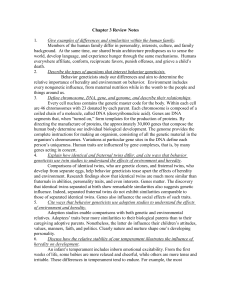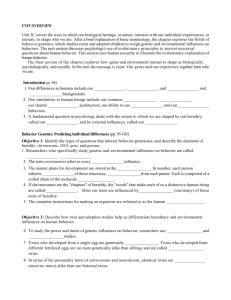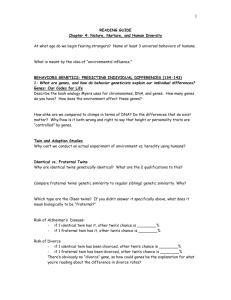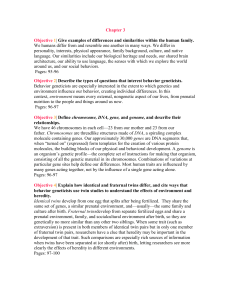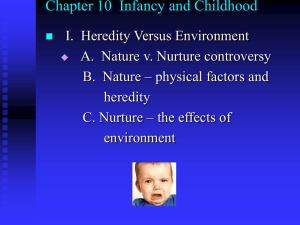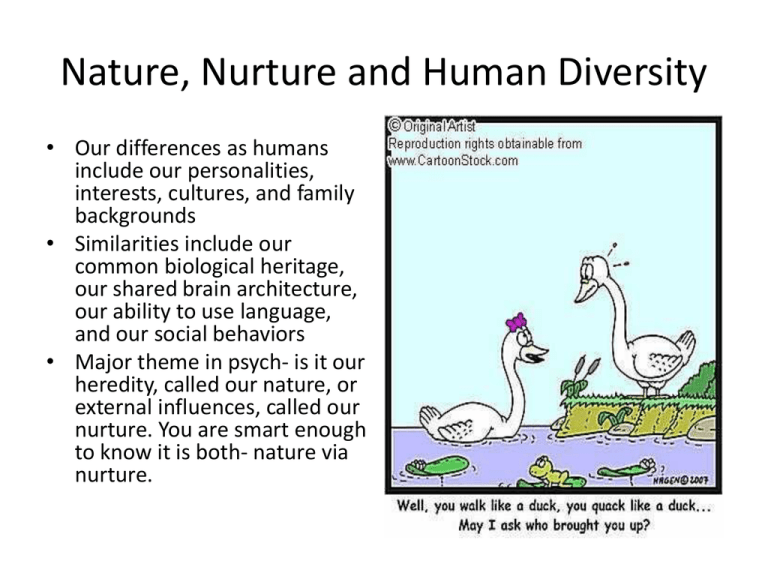
Nature, Nurture and Human Diversity
• Our differences as humans
include our personalities,
interests, cultures, and family
backgrounds
• Similarities include our
common biological heritage,
our shared brain architecture,
our ability to use language,
and our social behaviors
• Major theme in psych- is it our
heredity, called our nature, or
external influences, called our
nurture. You are smart enough
to know it is both- nature via
nurture.
Behavioral Genetics
• Researchers who
specifically study
genetic and
environmental
influences on behavior
are called behavior
geneticists
• The term environment
refers to nongenetic
influence
Behavioral Genetics
• Master plan for
development- in
chromosomes; 46 total, 23
from each parent, Each is
composed of the molecule
DNA.
• If Chromosomes are
chapters of heredity, genes
that make us uniquely
distinctive are genes.
Complete instructions on
making an organism is
referred to a as the human
genome.
Nature vs. Nurture- Twin and Adoption
Studies
•
•
•
•
•
•
•
To study genetic influence; researchers
use identical and fraternal studies
Identical- twins that develop from same
egg
Fraternal- twins that develop from
different eggs- no more genetically alike
than siblings
Identical twins are more alike than
fraternal when it comes to personality
Twin pairs treated alike; But similarities
could not be attributed to treatment
When twins are raised apart, researchers
can see the influence of environment
Personalities of adopted children do not
resemble adoptive parents. However,
shows parenting matters by scoring higher
than biological parents on intelligence
tests
How does temperament influence
Heredity?
• Inborn personality that shows
emotional excitabilitytemperament which DOES
endur over time.
• From the first weeks of life,
difficult babies- irritable,
intense, unpredictable, while
easy babies display cheerful,
relaxed, and predictable
• Faced with a new or strange
situation, anxious infants
become more physiologically
aroused than less excitable
infants.
Interaction of Genes and Environment
• The extent to which variation
among individuals is attributed
to genes is called heritability.
Heritable individual
differences do not necessary
imply heritable group
differences.
• Genes are self regulating;
rather than acting as a
blueprint leading to same
result, they react to the
environmental context.
• Human differences thus are
always the result of genetic
and environmental influences
Interaction of Genes and Environment
• Thus, we are the products of the
interaction of our genetic
predisposition and our
surrounding environment
• Environments trigger activity in
genes and out genetically
influenced traits evoke responses
in other people. This may explain
why fraternal twins recall greater
variations in their early family life
than do identical twins
• Molecular genetics- the subfield
of biology that seeks to identify
some of the many genes that
influence normal human traits
Evolutionary PsychologyUnderstanding Human Nature
• Evolutionary psychologistsResearchers who study natural
selection and the adaptive
nature of human behavior
• Focus on what makes people
alike
• Natural Selection- traits that
lead to increased reproduction
and survival will be most likely
to be passed on to succeeding
generations
• Genetic mutations are random
errors in genetic replication
that are the source of all
genetic diversity
Evolutionary PsychologyUnderstanding Human Nature
• Genetic constraints on human
behavior are genetically looser
than those on animal behavior.
The human species’ ability
learn and therefore to adapt in
responding to different
environments contributes to
our fitness, defined as our
ability to survive and
reproduce. Because of our
genetic legacy, we love the
tastes of sweets and fats,
which we tend to store, even
though famine is unlikely in
industrialized societies.
•
Gender Differences in Sexuality and
Mating Preferences
• Gender- characteristics that make
us Male of Female- These
characteristics are subject to
social and biological influences.
• Males are more likely to engage
in casual impulsive sex, and they
are more likely to initiate sexual
activity. This is an example of a
gender difference.
• Cross cultural research reveals
that men judge women as more
attractive if they have a youthful
appearance, whereas women
judge men who appear dominant,
bold, affluent as more attractive.
Criticism of Evolutionary Psychology
• Critics argue that it often
works backward to propose a
hindsight explanation
• Gender differences in mate
preferences are largest in
cultures characterized by
greater gender inequality.
• Evolutionary Psychologists
counter the criticisms by
noting the sexes, having faced
similar adaptive problems, are
more alike than they are
different. They also note that
evolutionary principles offer
testable predications.
Parents and Peers
• Prenatal DevelopmentEnvironmental influences
began during this period.
• Rosenweig and Krechdiscovered that rats raised
from a young age in enriched
environments had thicker
brain cortexes than animals
raised in isolation.
• Experience shapes the brain
by preserving activated neural
connections and allowing
connections degenerate. This
process called pruning, results
in a massive loss of unused
connections by puberty
Whose more important? Parents and
Peers
• The idea that parents shape their
children’s futures come from
Freudian psychiatry and
psychology
• Parents influence- political
attitudes, personal manners, and
religious beliefs
• In areas such as personality , the
environment siblings share at
home accounts for less than 10
percent of their differences.
• Experiments with peers have
powerful effect on how children
develop, partly as a result of a
selection effect by which kids
seek out others with similar
attitudes and interests.
Cultural Influences
•
•
•
•
•
Culture- the enduring behaviors, ideas,
attitudes, values, and traditions of a group
of people and transmitted from one
generation to the next
Human culture preserves innovation,
which is deprived of our mastery of
language, so that we can pass it on to
future generations. Culture also enables an
efficient division of labor.
All cultural groups evolve their own rules
for expected behavior, called norms
One such rule involves the buffer zone that
people maintain around their bodies,
called personal space
The speed at which culture changes is
much faster than the pace of evolutionary
changes in the human gene pool
Individualist vs. Collectivist Cultures
• Cultures based on
individualists value personal
control and individual
achievement. These cultures
include North America,
Western Europe, and Australia
• In contrast, cultures based on
collectivism value
interdependence, tradition,
and harmony. Examples of
these cultures include Korea,
Japan, and China.
• Picture represents collectivist
act
Individualist vs. Collectivist Cultures
• Individualist culture cons- more
loneliness, homicide, stress
• Individualist foster independence,
while collectivist cultures value
emotional closeness
• Collectivist grow up with a sense
of family self which states that
what shames or honors the
person also shames or honors the
family.
• In general, differences between
groups are smaller than personto- person differences within a
group
Gender Development
• Among your 46
chromosomes, 45 are unisex.
• Woman’s characteristicsmore fat, less muscle, few
inches shorter – More likely
to suffer depression,
anxiety, and eating
disorders.
• Men’s Characteristics- more
suicide, alcohol
dependence, autism, color
blindness, ADHD, antisocial
personality disorder
Gender Development
• Aggression is defined as physical
or verbal behavior that is
intended to hurt someone.
• Throughout the world, men are
likely than women to engage in
hunting, fighting, and warring.
• The aggression gender gap
pertains to physical rather than
verbal aggression.
• Men’s Perception vs. Women's
Perception- Men- dominant,
forceful, independent, directive
vs. Women’s- deferential,
nurturing, affiliative
• These perceived differences
occur throughout the world.
Gender Development
• According to Carol Gilligan,
women are concerned than men
in making connections with
others
• This difference is noticeable in
how children play, and it
continues throughout the teen
and adult years. Girls play in
groups that are smaller and less
competitive than boys’ groups.
• Because they are more
interdependent, women are likely
to use conservation to explore
relationships, while men are likely
to use conversation to
communicate relationships.
Gender Development
• Women tend and
befriend- for example,
they turn to others for
support, especially when
coping with stress.
• Gender differences in
power, connectedness,
and other traits peak in
late adolescence and
early adulthood. By age
50, the differences have
decreases
Role of Sex Hormones in Biological
Development
•
•
The 23rd pair of chromosomes
determines the developing person’s
sex. Mother contributes a X
chromosome; Father contributes Y,
the testes begin producing the
hormone testosterone. In about the
seventh, this hormone initiates the
development of external male
organs.
Sex chromosomes control hormones
that influence the brain’s wiring. In
adulthood, part of the frontal lobe,
an area involved verbal fluency, is
thicker in women. Part of the brain’s
parietal cortex, a key area for space
perception, is thicker in men.
Importance of Gender Roles
• Our expectations about the
way men and women behave
define our culture’s gender
roles.
• Gender roles are not rigidly
fixed by evolution, as
evidenced by the fact that
they vary across cultures and
over time. Nomadic societyminimal division of labor by
sex; by contrast, in agricultural
societies, women remain close
to home while men roam
freely, herding cattle or sheep.
Importance of Gender Roles
•
•
•
Our individual sense of being male or
female is called our gender identity.
The degree to which we exhibit
traditionally male of female traits is
called gender typing.
According to social learning theory,
children learn gender- linked
behaviors by observing and imitating
others and being rewarded or
punished. When families discourage
gender typing, children do organize
themselves into boy and girl worlds.
Children also learn from their gender
schemas what it means to be male or
female and adjust their behavior
accordingly, thereby demonstrating
that cognition is important in the
formation of gender identity
Reflections on Nature vs. Nurture
• As brute strength becomes
less relevant to power and
status, gender roles are
converging.
• We are the product of both
nature and nurture, but we
are also s system that is open.
We know this because a
biopsychosocial approach to
development shows that no
single factor is all powerful.
• The principle that we should
prefer the simplest of
competing explanations for a
phenomenon called Occam’s
Razor
Nature, Nurture, and Human Diversity
Similarities
Differences
Genes: Same set of
chromosomes
Genes: Genetic anomalies
may make us different
Biology: Organs and body
functions same
Biology: May change
during development
Brain: Same brain
architecture
Brain: Asymmetry of brain
across genders
Behaviors: Speak language
Behavior: Speak different
languages
25
Culture and the Self
26
Reflections on Nature and Nurture
27



